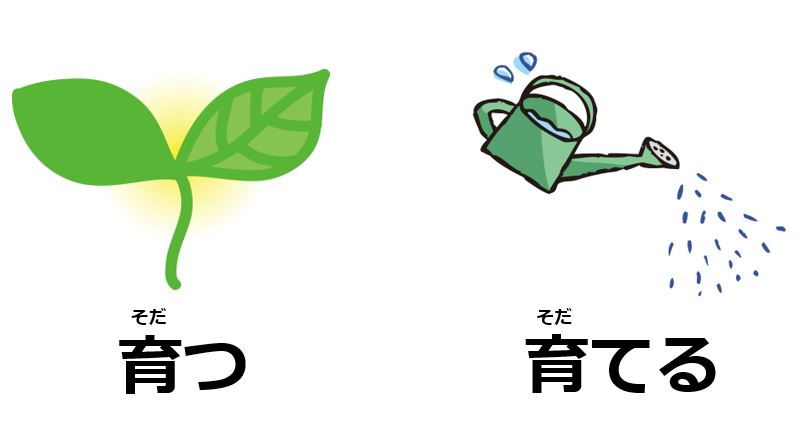Last time, you tackled some advanced topics involving Japanese adjectives, such as “科学に詳しい人” and “近いカフェ VS. 近くのカフェ.” Your knowledge of Japanese parts of speech is greatly increasing. In this lesson, you will also take on advanced topics in Japanese verbs.
Usage of Verbs When They Can Be Both Intransitive and Transitive
If you try to categorize intransitive verbs, there will be two groups: The first is volitional (actions with people’s intention), such as “走る: to run” and “泳ぐ: to swim.” The second is non-volitional (actions without people’s intention), such as “開く: to open,” and “落ちる: to drop.” The latter group likely has equivalent transitive verbs. In English, you can use verbs like “to open” as both an intransitive and a transitive verb, e.g. “The door will open,” and “I will open the door.” However, Japanese requires you to use different forms for intransitive and transitive verbs respectively.
The Difference Between Intransitive and Transitive Verbs
Intransitive Verbs: 開く to open
| ドア は / が | 開く / 開きます |
| Topic / Subject | Intransitive Verb |
| The door will open. | |
When you walk toward an automatic door, the door automatically opens. In such a situation, the door has to be the subject set by the particle は or が, and there is no object because the door alone will move. That is to say, intransitive verbs indicate automatic or natural actions.
Transitive Verbs: 開ける to open
| [私 は / が] | ドアを | 開ける / 開けます |
| [Topic / Subject] | Direct Object | Transitive Verb |
| [I] will open the door. | ||
When you open a door, needless to say, the door is opened by you. In such situations, the door has to be the object set by the particle を, and there have to be subjects because someone will open the door. That is to say, transitive verbs indicate intentional actions.
| Intransitive | ドア は / が(開く / 開きます)。 |
| Transitive | ドアを(開ける / 開けます)。 |
As you already know, subjects can be omitted when the context clearly tells what or who you’re referring to. In the second example, the subject: 私 is omitted. Don’t be confused by the structure.
Advanced Topic: Sentences with Some Elements
Even if you use intransitive verbs, you sometimes need to use the particle を. Take it easy. By understanding the particles’ functions, you can easily figure out the meanings of sentences.
Intransitive Verbs: 出る: to go out, leave, depart
| 電車 は / が | 駅を | 出る / 出ます |
| [Topic / Subject] | Location to Leave | Intransitive Verb |
| The train will leave the station. | ||
Transitive Verbs: 出す: to take out, let out, put out
| [私 は / が] | 電車を | 駅から | 出す / 出します |
| [Topic / Subject] | Direct Object | Starting Point | Transitive Verb |
| [I] will take the train out from the station. | |||
The second example sounds a little weird, but he/she may be a train driver or engineer. The point here is that the particle を can appear in sentences with intransitive verbs if it doesn’t work as a direct object.
Note: In the second example above, you may have noticed that the particle から is used with 駅 while the particle を is used with 駅 in the first example. This is because using the same particles multiple times in a single sentence may cause confusion and therefore is not recommended in Japanese grammar.
[私 は / が] 電車を駅を 出す / 出します。=> Wrong!
[adsense]
Vocabulary List: How to Distinguish Between Intransitive and Transitive Verbs
Although the multiple forms are hard to memorize, there are several patterns in the conjugations. We will show you frequently used verbs below. Please do not try to memorize them all at once, but tackle them step by step.
- Pattern 1
- If verbs end with -aru, they are intransitive verbs.
- They become transitive verbs by replacing -aru with eru.
| Intransitive Verbs | Transitive Verbs |
|---|---|
| 上がる: to rise | 上げる: to raise |
| 集まる: to gather | 集める: to collect |
| 高まる: to increase | 高める: to increase |
| 伝わる: to spread, go around | 伝える: to tell, inform |
| 終わる: to finish, to end | 終える*: to finish, end |
| 変わる: to change | 変える: to change |
| かかる: to take (resources) | かける: to spend, take (time) |
| 決まる: to be decided | 決める: to decided |
| 下がる: to fall, lower, drop | 下げる: to lower, pull down, reduce |
| 閉まる: to close | 閉める: to close |
| 止まる: to stop | 止める: to stop |
| 始まる: to start | 始める: to start |
| 曲がる: to bent, curve, turn | 曲げる: to bend, curve |
| 見つかる: to be found | 見つける: to find |
*終える sounds a little formal and 終わる can be used as transitive verb as well.
- Pattern 2
- If verbs end with -reru, they are intransitive verbs.
- They become transitive verbs by replacing -reru with su.
| Intransitive Verbs | Transitive Verbs |
|---|---|
| 壊れる: to break | 壊す: to break |
| 倒れる: to fall (to the ground), collapse | 倒す: to throw down, knock down |
| 汚れる: to become dirty | 汚す: to make (it) dirty |
- Pattern 3
- If verbs end with -reru, they are intransitive verbs.
- They become transitive verbs by replacing -reru with ru.
| Intransitive Verbs | Transitive Verbs |
|---|---|
| 売れる: to be sold | 売る: to sell |
| 折れる: to break, snap | 折る: to break, snap |
| 切れる: to be cut | 切る: to cut |
| 撮れる: to be photographed, be recorded | 撮る: to take (photo), to record (video) |
| 割れる: to break | 割る: to break |
- Pattern 4
- If verbs end with -areru, they are intransitive verbs.
- They become transitive verbs by replacing -areru with u.
| Intransitive Verbs | Transitive Verbs |
|---|---|
| 生まれる: to be born | 生む: to give birth |
- Pattern 5
- If verbs end with -su, they are transitive verbs.
- They become intransitive verbs by replacing -su with ru.
| Intransitive Verbs | Transitive Verbs |
|---|---|
| 写る: to be in a photo, be projected | 写す: to copy, transcribe, photograph |
| 帰る: to go back | 帰す: to let a person go back |
| 返る: to be returned | 返す: to return |
| 出る: to go out, leave, depart | 出す(*exception): to take out, let out, put out |
| 直る: to be fixed, be repaired | 直す: to fix, repair |
| 治る: to be cured, be recovered | 治す: to cure, heal |
| 残る: to remain, stay | 残す: to leave |
| 回る: to turn, rotate, revolve, spin | 回す: to turn, rotate, spin |
| 戻る: to be back | 戻す: to return |
- Pattern 6
- If verbs end with -asu, they are transitive verbs.
- They become intransitive verbs by replacing -asu with eru.
| Intransitive Verbs | Transitive Verbs |
|---|---|
| 遅れる: to be delayed | 遅らす: to delay |
| 逃げる: to run away, escape | 逃がす: to set … free, let …go |
| ぬれる: to get wet | ぬらす: to wet |
| 冷える: to get cold | 冷やす: to cool, to make … cold |
| 増える: to increase | 増やす: to increase |
| 揺れる: to shake | 揺らす: to sway, shake |
| 消える: to disappear | 消す(*exception): to erase, turn off |
- Pattern 7
- If verbs end with -asu, they are transitive verbs.
- They become intransitive verbs by replacing -asu with u.
| Intransitive Verbs | Transitive Verbs |
|---|---|
| 動く: to move | 動かす: to move |
| 乾く: to dry | 乾かす: to dry |
| 飛ぶ: to fly | 飛ばす: to fly, send (up), splash |
| 泣く: to cry | 泣かす: to make … cry |
| 沸く: to boil, be excited | 沸かす: to boil, excite |
- Pattern 8
- If verbs end with -osu, they are transitive verbs.
- They become intransitive verbs by replacing -osu with iru.
| Intransitive Verbs | Transitive Verbs |
|---|---|
| 起きる: to get up | 起こす: to wake (up) |
| 落ちる: to fall, drop | 落とす: to drop |
| 降りる: to get off | 降ろす: to drop (off), unload |
| 下りる: to go down | 下ろす: to pull down |
Others
| Intransitive Verbs | Transitive Verbs |
|---|---|
| 開く: to open | 開ける: to open |
| 空く: to become vacant, empty | 空ける: to vacant, empty |
| 聞こえる: to be heard | 聞く: to hear, listen (to) |
| 片づく: to be in order, be finished | 片づける: to put … in order, settle |
| 育つ: to grow | 育てる: to raise |
| 立つ: to stand | 立てる: to set up, put up |
| 建つ: to be built | 建てる: to build |
| 付く: to stick (to) | 付ける: to spread, apply, stick, attach |
| 続く: to continue | 続ける: to continue |
| 届く: to received | 届ける: to send |
| 焼ける: to be burned | 焼く: to burn |
| 見える: to be seen | 見る: to look (at), watch, see |
| 寝る: to sleep | 寝かせる: to send … to bed |
| 乗る: to ride, take | 乗せる: to give a person a ride |
Summary
- When verbs can be both intransitive and transitive verbs:
- Intransitive verbs indicate automatic or natural actions
- Transitive verbs indicate intentional actions
- Transitive verbs need objects set by the particle を
- Intransitive verbs can be with the particle を unless it works as direct object
- Using the same particles multiple times in a sentence is not recommended
Again, you don’t have to memorize the vocabulary which we have shown so far all at once. All you need to know here is what we have summarized above. You can naturally increase your vocabulary as you proceed with your learning. Now, you have completed even the advanced topics in the parts of speech section. Great Job! Next, you will learn one of the unique elements to Japanese: Sentence Ending Particles.

Advanced Adjectives: Noun Phrases & Particular Particles

Sentence Ending Particles: ね, よ, and よね





